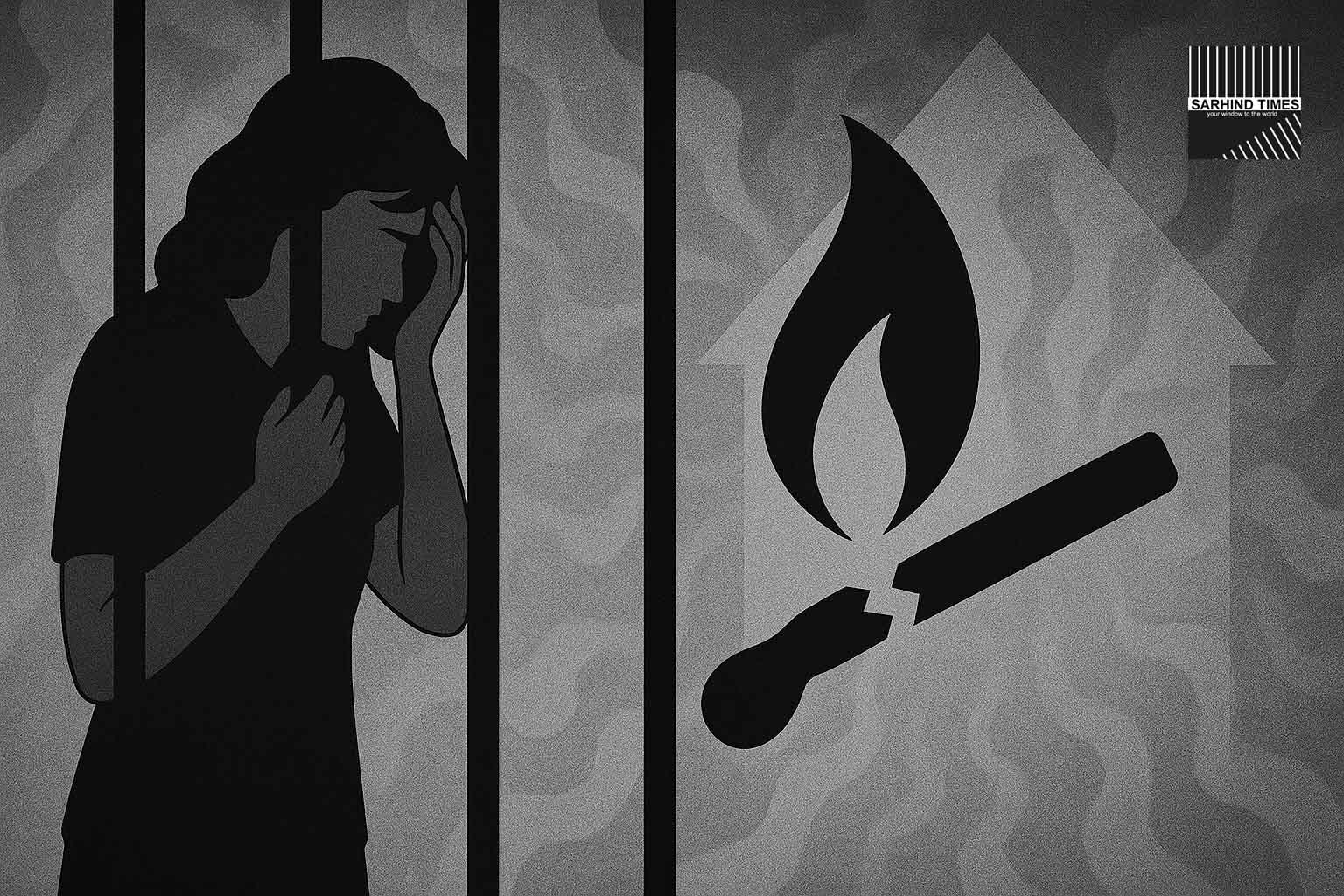Patna, October 12, 2025 — In a horrifying incident that has stirred shock and outrage across Bihar, police arrested a man accused of dousing his second wife in petrol, releasing LPG from a cylinder, and setting her on fire after she opposed his plan to marry his girlfriend. The victim, reportedly in critical condition, was rushed to hospital amid severe burns. The case underlines lingering vulnerabilities in domestic violence protection, law enforcement responsiveness, and social norms surrounding marriage, gender justice, and power.
The accused has been identified as Vikas Kumar, of a village in Nalanda district. He is alleged to have married Sunita Devi, aged 25, about five years ago — only for her family to later learn he was already married and had not divorced his first wife. When Sunita resisted his plan to marry a girlfriend, Vikas allegedly carried out the grievous act.
Local authorities say neighbours raised the alarm after witnessing smoke and cries; the victim was severely burned and is currently in hospital under critical care. Forensic teams have been dispatched, statements are being recorded, and the investigation is ongoing. Women’s rights groups have demanded swift justice, compensation for the victim, and systemic safeguards to prevent recurrence.
This case triggers urgent questions: How did such brutality occur within the home? What gaps in reporting, protection and enforcement allowed this escalation? And how can the law, social norms, and state action better defend women whose domestic struggles are invisible until tragedy strikes?
Incident Details & Initial Investigation
Chronology as per police / victim’s family
- Marriage and hidden past
According to the victim’s father, the marriage between Vikas and Sunita took place five years ago. After the wedding, they discovered that Vikas was already married — a fact not disclosed earlier. - Conflict over marriage plans
Vikas allegedly wanted to marry another woman (his girlfriend). When Sunita protested, tensions escalated. - Attack execution
On the fateful day, Vikas is said to have doused Sunita with petrol inside their home, opened an LPG cylinder to amplify the fire, and ignited it. The blaze severely scorched her. - Rescue & hospitalization
Neighbours, alarmed by screams and smoke, intervened, pulled her out, and rushed her to hospital with serious burn injuries. - Investigation steps
Police collected forensic samples, recorded statements from neighbours and family, begun lodging charges under relevant IPC sections. The accused has been arrested
While some details remain preliminary, the facts as reported are stark and evoke deep societal outrage.
Broader Context: Domestic Violence & Women’s Safety in Bihar / India
This tragic incident is not isolated — it reflects persistent systemic challenges in India’s landscape of gender-based violence.
Prevalence & under-reporting
- Nationally, research indicates that around 33–41 % of ever-married women report experiencing domestic violence in their lifetime.
- In Bihar, data show some of the highest prevalence rates: in NFHS-5, Bihar was among the top states with ~ 40 % of women reporting spousal violence at some point.
- Yet, reporting is low. Cultural stigma, fear of retaliation, economic dependency, social pressure, weak institutional responses, and lack of awareness deter many from accessing legal help.
Bihar’s rank and challenges
- Bihar ranks second only to Karnataka in reports of domestic violence among women, according to some sources.
- Local studies in rural Bihar show multiple overlapping vulnerabilities: women in lower castes, limited education, economic fragility, and constrained mobility face more abuse.
- Official records suggest increasing crime against women in Bihar. For instance, in 2021–22, among crimes against women, domestic violence had large shares in the registered cases.
Types of abuse & drivers
Violence against women inside households takes multiple forms — physical, sexual, psychological, economic. Economic abuse (withholding funds, controlling property, forcing dependence) is often overlooked but is a persistent driver.
Key structural factors that exacerbate abuse include patriarchal norms, gender inequality, low education, poverty, alcohol/substance abuse, social acceptance of male control, and weak law enforcement.
Failures in safety nets
When complaints are filed, delays, bureaucratic obstacles, under-resourced women’s help desks, slow police action, and lack of protection for victims during and after litigation often dissuade survivors. Many cases never reach conviction.
In Bihar, even with the ban on alcohol and some reported declines in crimes against women, the deeper social norms and structural deficits continue to challenge enforcement.
Legal Framework & Challenges
Relevant laws & provisions
- Indian Penal Code (IPC): Sections such as 302 (murder), 326A/B (causing grievous burns), 498A (cruelty by husband / relatives), 3/4 of Dowry Prohibition Act, etc.
- Protection of Women from Domestic Violence Act, 2005 (PWDVA): provides civil remedies for women (protection orders, residence orders, maintenance). However, it does not directly deal with serious criminal acts like attempted murder — those fall under IPC.
- Dowry / dowry death laws: if dowry demands or harassments are implicated, sections under Dowry Prohibition Act or IPC might apply.
- Criminal Procedure Code (CrPC): remand, investigation, charge sheet, trial procedure.
Investigation & prosecution challenges
- Collection of evidence, forensics: Burn cases are hard — delay weakens forensic traces. Investigators must act swiftly.
- Victim protection: Ensuring safety, medical care, psychological support while under legal process.
- Witness intimidation: Family / social pressures may intimidate witnesses from testifying.
- Delay & backlog: Courts are burdened; criminal trials often stretch years.
- Conviction rates: In many serious cases, the conviction rate is relatively low, partly due to weak evidence, procedural flaws, and lax prosecution.
- Coordination among agencies: Police, forensic labs, women’s commissions, NGOs, legal aid — must coordinate.
- Reluctance to register FIR / police apathy: In many domestic violence cases, initial police action is sluggish, or cases are downgraded or delayed.
Judicial precedents & reform demands
- Several courts have emphasized speedy justice for grievous offences, especially against women.
- For heinous crimes against women (rape, dowry death, acid attacks), courts have sometimes directed fast-track courts or monitoring.
- However, lower priority crimes or domestic disputes seldom get such attention.
- Rights activists demand greater implementation of victim compensation statutes, better funding of forensic and women’s help infrastructure, and social accountability for police and judiciary.
Social & Gender Perspective: Why Such Violence Persists
Patriarchy & Masculine entitlement
At the core lies entrenched patriarchal belief: that a man may exert absolute control in marital life, including decisions on marriage, relationships, finances. Resistance by women to such dominance is often met with violence.
In this case, the act of violence was precipitated by the wife’s refusal to accept a second marriage. The reaction was extreme, but the trigger reflects how some men may view women’s autonomy as defiance.
Polygamy, secrecy, and marital power imbalance
While polygamy is illegal among Hindus, and restricted under personal laws in many religious communities, informal second marriages or secret relationships occur. When women discover deceptions, conflict arises — often handled in silence, until escalation. In many households, women lack recourse to question or challenge.
Social pressure, stigma, victim silence
Many women remain silent for fear of stigma, losing social standing, family, children, or due to economic dependence. Communities may discourage “airing marital problems.” In many rural / conservative settings, the family is complicit in suppressing voices.
Failure of preventive mechanisms
Community vigilance, neighborhood intervention, local women’s groups, panchayat mechanisms, NGO outreach, counseling centers, helplines — often weak or absent in rural settings. The escalation from abuse to attempted murder often happens when no intermediate check intervenes.
Intersection with caste, class, rural deprivation
In rural Bihar, marginalised castes and economically weak families face compounding vulnerabilities. Access to justice, health, safe space, mobility — all less available. Women in these contexts are more susceptible to extreme violence.
Implications & What Must Follow
Immediate measures needed
- High priority investigation
Police must ensure medical records, forensic evidence, scene of crime investigations, and arrest of accused with minimal delay; avoid procedural lapses. - Protection of victim & family
The woman must receive burn treatment, protection from retaliation (safe shelter, security), counseling, legal aid. - Fast-track prosecution
Given the gravity, the case should be placed in a fast-track court or under judicial monitoring. - Compensation & relief
State must consider immediate interim financial relief to victim’s family, support for medical costs, and use victim compensation schemes. - Community & media reckoning
Local awareness, media attention, and civil society must keep pressure to ensure no cover-up or delay.
Longer term reforms
- Strengthen homicide / burn case forensic capacity
Adequate labs, training, mobile forensic units in rural districts. - Improved domestic violence early intervention
Strengthening protection officers, local women complaint centers, helplines, community outreach so abuse is reported earlier before escalation. - Police sensitization & accountability
Training in handling gender crimes, performance metrics for handling violence against women, internal oversight to prevent negligence. - Legal & judicial reform
Faster trials, more judges in women / violence courts, victim support cells at all court levels. - Social transformation
Education, gender norms change, legal literacy among women, public campaigns to reject violence, male ally programs. - Monitoring & accountability
State women’s commissions, National Commission for Women, NHRC, NGOs should monitor such cases, publish status, litigate for systemic improvement.
Conclusion
This horrifying episode in Bihar — a man allegedly trying to burn alive his wife to clear his path to remarry — reflects a brutal intersection of patriarchal entitlement, weak protective mechanisms, institutional inertia, and social silence. The immediate demand is swift justice and protection for the victim. But beyond that, it is a challenge to the collective conscience: to build systems and societies where no woman must fear death within her home for asserting a voice.
If the state, judiciary, police, civil society, media and communities are serious about women’s safety, this case must not fade into the dockets unread. The difference lies in whether this becomes a catalyst for systemic reform or another tragedy buried behind statistic lines.
#Crime #Bihar #WomensSafety #DomesticViolence #LawAndOrder























+ There are no comments
Add yours